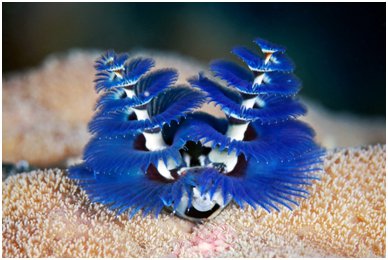Exploring the diversity of Christmas tree worms in Indo-Pacific coral reefs
Genetics comes to the rescue in solving a mystery surrounding psychedelically coloured marine worms!

Blue colour morph of Christmas tree worm (Spirobranchus corniculatus), on coral reef off Lizard Island, Australia.
Image: Alexander Semenov© Alexander Semenov
Coral reefs are complex and highly productive ecosystems that have the highest biodiversity in the sea. This biodiversity is dominated by invertebrates, and some of the most conspicuous invertebrates of shallow coral reefs are Christmas tree worms or calcareous tubeworms of the genus Spirobranchus. Because identifying species in this group has been rather problematic, we used genetics to help us and were surprised by our finding that what looked like three species turned out to be just one.
The festive common name “Christmas tree worm” refers to their spectacular brightly coloured cones of spiralling branchia (hence the Latin name), and is reserved for those members of the genus that live in close association with large corals. The traditional way to tell species of Christmas tree worms apart was to look at the structure (the operculum) the animals use to shut the tube when they withdraw into it. The operculum is armed with a number of calcareous spines used to ward off potential intruders. The problem is that spine shapes are too variable to be reliable indicators biodiversity or number of species.

Yellow and orange colour morphs of Christmas tree worm (Spirobranchus corniculatus), on coral reef off Leyte, in the Philippines.
Image: O. Paderanga© O. Paderanga
To answer the question whether the shape and number of spines can use used to recognise worm species, we sampled 90 specimens of the Spirobranchus corniculatus-complex from Australia, Fiji and the Coral Triangle, the marine area that includes the waters of Indonesia, Malaysia, the Philippines, Papua New Guinea, Timor Leste, and Solomon Islands. This species complex tentatively includes three morphologically-defined species, S. corniculatus, S. cruciger, and S. gaymardi. We examined variability of both nuclear and mitochondrial genes to test whether the complex includes three genetically distinct lineages identifiable by their opercula, the tube plugs.
It is well known that when examined using genetic methods, widely distributed marine species often turn out to comprise a number of species with more limited distributions. Therefore, this is what we expected to see in Christmas tree worms. To our surprise, molecular data showed that the S. corniculatus complex of three morphospecies is in fact a single, morphologically variable species living across the Central Indo-Pacific.
Of course, this study is the only the first step towards answering the question "how many Christmas tree worm species live associated with corals?". This question is important because assessing and monitoring reef health is crucial in reef recovery, and Spirobranchus worms have been proposed as bioindicator species for reef health. Further, Spirobranchus is an easy-to-recognize, colourful, charismatic species that would be ideal to use in volunteer-based reef monitoring programs. Our capacity to utilize Spirobranchus as a bioindicator of reef health must be rooted in a clear understanding of its biodiversity, a task now made easier due to our study’s conclusion of a single, broadly distributed Spirobranchus corniculatus species.
Dr Elena Kupriyanova
Research Scientist, AMRI
More information:
Willette, D.A., Iñiguez, A.R, Kupriyanova, E.K., Starger, C.J. Varman,,T., Toha, A.H., Maralit B.A. & P.H. Barber. (2015). Christmas tree worms of Indo-Pacific coral reefs: untangling the Spirobranchus corniculatus (Grube, 1862) complex. Coral Reefs

